Stars & Eclipses
Most pics courtesy of NASA
Cas A Supernova Remnant in X-Rays


Explanation: The complex shell of a star seen to explode 300 years ago is helping astronomers to understand how that star exploded. This Chandra Observatory image of supernova remnant Cassiopeia A (Cas A) shows unprecedented detail in three x-ray colors. The relationship between brightness, color, and position of material in the image indicates where in the star this material was just before the explosion. Bright knots on the left, for example, contain little iron, and so are hypothesized to originated from a higher layer than outer red filaments, which are iron rich. The blue region on the right is seen through absorbing dust, and so appears depleted of low-energy x-rays. It takes light ten years to cross the gas shell of the Cas A supernova remnant, which is 10,000 light-years distant. Most of the elements that make people and planets were produced in supernova explosions.
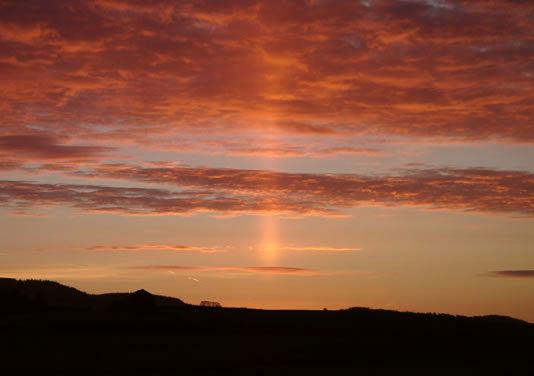
Explanation: Have you ever seen a sun pillar? When the air is cold and the Sun is rising or setting, falling ice crystals can reflect sunlight and create an unusual column of light. Ice sometimes forms flat, stop-sign shaped crystals as it falls from high-level clouds. Air resistance causes these crystals to lie nearly flat much of the time as they flutter to the ground. Sunlight reflects off crystals that are properly aligned, creating the sun-pillar effect. In the above picture, a sun-pillar reflects light from a setting Sun.
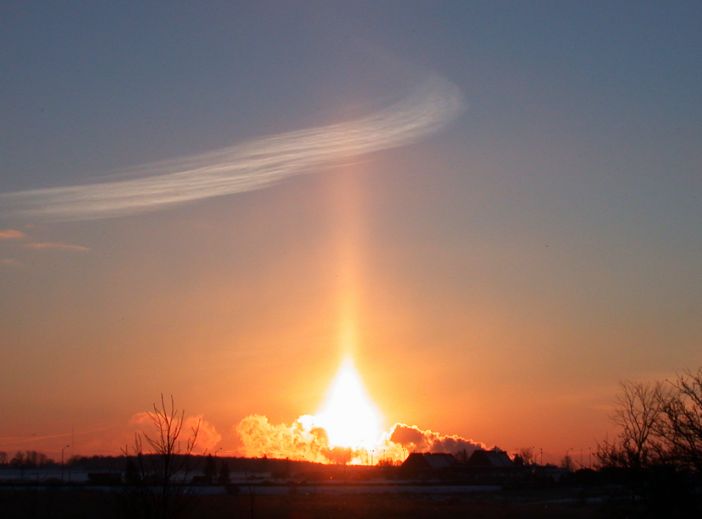
Explanation: On January 16, NASA's space shuttle Columbia roared into blue morning skies above Kennedy Space Center on STS-107, the first shuttle mission of 2003. But this is not a picture of that launch! It was taken on the morning of January 16 though, at sunrise, looking eastward toward Lake Ontario from just outside of Caledon, Ontario, Canada. In the picture a sun pillar, sunlight reflecting from ice crystals gently falling through the cold air, seems to shoot above the fiery Sun still low on the horizon. By chance, fog and clouds forming over the relatively warm lake look like billowing smoke from a rocket's exhaust plume and complete the launch illusion. Amateur photographer Lauri Kangas stopped on his way to work to record the eye-catching sun pillar launch.
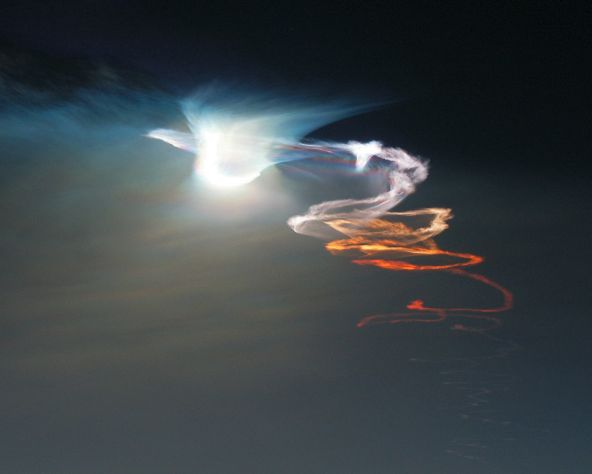
Explanation: Bright light from a setting Sun and pale glow from a rising Moon both contribute to this stunning picture of a rocket exhaust trail twisting and drifting in the evening sky. Looking west, the digital telephoto view was recorded from Table Mountain Observatory near Wrightwood California, USA on September 19, 2002, four days before the autumnal equinox. The rocket, a Minuteman III solid fuel missile, was far down range when the image was taken. Launched from Vandenberg Airforce Base, it carried its test payload a thousand miles out over the Pacific Ocean. The red/orange color from the setting Sun dramatically intensifies near the top of the rocket trail, but below the sunset line, the very bottom of the trail is faintly illuminated from the east by a nearly full Moon. Still in full sunlight, the bright diffuse cloud at the top of the trail, the result of a rocket stage separation, is tinged with rainbows likely produced by high altitude ice crystals forming in the exhaust plume. Astronomer James Young comments that the cloud takes on the appearance of a white dove flying from right to left across the sky.
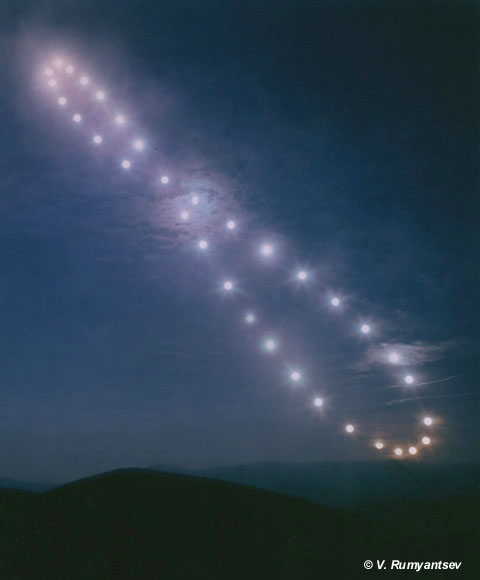
Explanation: If you took a picture of the Sun at the same time each day, would it remain in the same position? The answer is no, and the shape traced out by the Sun over the course of a year is called an analemma. The Sun's apparent shift is caused by the Earth's motion around the Sun when combined with the tilt of the Earth's rotation axis. The Sun will appear at its highest point of the analemma during summer and at its lowest during winter. Analemmas created from different Earth latitudes would appear at least slightly different, as well as analemmas created at a different time each day. The analemma pictured to the left was built up by Sun photographs taken from 1998 August through 1999 August from the Ukraine. The foreground picture from the same location was taken during the early evening in 1999 July.
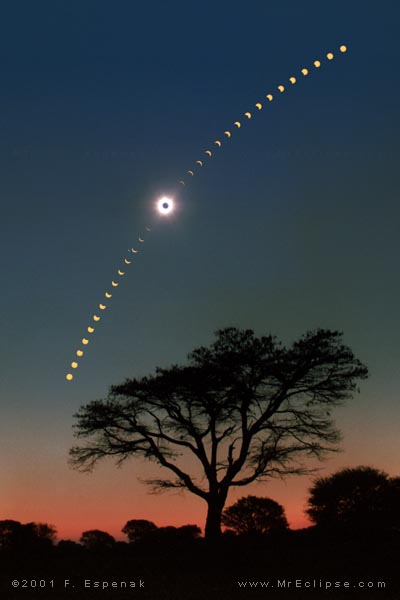
Explanation: On December 4th, 2002, for the second time in as many years, the Moon's shadow will track across southern Africa bringing a total solar eclipse to African skies. Reaching Africa just before 6:00 Universal Time, the narrow path of totality - corresponding to the path of the Moon's umbra or dark central shadow - will run eastward through Angola, Namibia (Caprivi Strip), Botswana, Zimbabwe, South Africa's Kruger National Park, and Mozambique. Moving out across the Indian Ocean it will ultimately cross onto the Australian continent at sunset (around 9:10 UT). Observers directly in this path could catch at most a minute or so of the eclipse at its total phase, but at least a partial eclipse will be visible over much of Africa, Australia, some parts of Indonesia, and eastern Antarctica. While watching last year's June 21 eclipse, astronomer Fred Espenak recorded a series of exposures used to construct this dramatic composite image. The sequence follows the 2001 geocentric celestial event from start to finish above a thorny acacia tree near Chisamba, Zambia.

Explanation: A lunar eclipse can be viewed in a leisurely fashion. Visible to anyone on the night side of planet Earth (weather permitting), totality often lasts an hour or so as the moon glides through the Earth's shadow. But a solar eclipse is more fleeting. Totality can last a few minutes only for those fortunate enough to stand in the path of the Moon's shadow as it races across the Earth's surface. For the April 29, 1995 annular solar eclipse, photographer Olivier Staiger was standing in Macara, Ecuador under partially cloudy skies. Just before the maximum annular eclipse phase he recorded this dramatic moment as a bird flew near the sun. The next solar eclipse, on June 10, 2002, will also be an annular one. Partial phases will be visible from eastern Asia, the Pacific Ocean and much of North America. Very accurate predictions of eclipses have long been possible.

Explanation: This stunning image shows remarkable and mysterious details near the dark central region of a planet-sized sunspot in one of the sharpest views ever of the surface of the Sun. Just released, the picture was made using the Swedish Solar Telescope now in its first year of operation on the Canary Island of La Palma. Along with features described as hairs and canals, are dark cores visible within the bright filaments that extend into the sunspot, representing previously unknown and unexplored solar phenomena. The filaments' newly revealed dark cores are seen to be thousands of kilometers long but only about 100 kilometers wide. Resolving features 100 kilometers wide or less is a milestone in solar astronomy and has been achieved here using sophisticated adaptive optics, digital image stacking, and processing techniques to counter the blurring effect of Earth's atmosphere. At optical wavelengths, these images are sharper than even current space-based solar observatories can produce. Recorded on 15 July 2002, the sunspot shown is the largest of the group of sunspots cataloged as solar active region AR 10030.
|